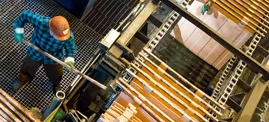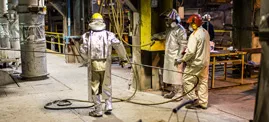General Information
The Głogów Copper Smelter comprises two process lines – Głogów I smelter and Głogów II smelter. Both use the technology of single-stage flash smelting of copper concentrates directly to blister copper with an approximately 98.5% Cu content. The final product is cathode copper with a Cu content of 99.99%, registered on the London Metal Exchange as grade A in accordance with the BS EN 1978:1998 standard and on the Shanghai Futures Exchange (SHFE) under the brands HMG-S and HMG-B. The Precious Metals Division of the Głogów smelter produces 99.99 pure silver in the form of pig sows and granulate, bars of gold with a 99.99% Au content, and technical selenium.
Silver in the form of pig sows, registered under the brand KGHM HG, has been issued Good Delivery certificates by the London Bullion Market Association and a certificate of registration on the New York Mercantile Exchange COMEX). All products of the Głogów Copper Smelter boast very stable and high quality guaranteed by their globally recognised market brands.
The Głogów smelter also operates divisions where metals and compounds present in copper ores are processed:
- the Lead Division, converting lead-bearing raw materials into crude lead, which is ultimately processed at the Legnica Copper Smelter to obtain refined lead, a commercial product offered by KGHM;
- two Electrorefining Divisions, which in addition to cathode copper units operate nickel recovery units producing nickel sulphate;
- two Sulphuric Acid Plants, converting process gas from flash furnaces into sulphuric acid.
The Głogów Copper Plant has implemented an Integrated Management System based on the following standards:
- ISO 9001 Quality Management System
- ISO 14001 Environmental Management System
- ISO 45001 Occupational Health and Safety Management System
- ISO 50001 Energy Management System
History
The construction of the Głogów I Copper Smelter in Żukowice near Głogów started in 1967, and the plant was pre-commissioned in July 1971. In April 1972, the Głogów I smelter achieved the production capacity assumed for the facility’s first stage, i.e. 80,000 tonnes of electrolytic copper per year. In July 1974, the construction of the second stage of the Głogów I smelter was completed, upping the annual output capacity to 160,000 tonnes of electrolytic copper. Copper was produced using shaft furnaces, which processed concentrate to copper matte with an approximately 52% Cu content.
In 1974, the construction of the second smelter was commenced – the Głogów II Copper Smelter. The technology used was cutting-edge and unique on a global scale: single-stage flash black copper smelting. The Głogów II Copper Smelter started production on 9 January 1978 with an annual designed capacity of 150,000 tonnes of electrolytic copper.
In 1990-1993, the Głogów Copper Smelter was extended by adding the Precious Metals Division for the recovery of precious metals from anode slime. The first batch of silver was produced on 14 September 1993.
The Lead Division, which had operated since 1973, was upgraded in 2000-2001. Following the start up of the fourth Doerschl furnace, since 2011 the division’s annual production capacity has been about 30,000 tonnes of crude lead.
At the Głogów I smelter, preparations for the change of shaft furnace to flash furnace technology started in 2014. In April 2015, shaft furnace No. 1 was shut down and decommissioned. Shaft furnaces No. 2 and 3 were shut down in July 2016, which marked an end to copper production in this technology at the Głogów I smelter. In October 2016, the world’s largest flash and electric furnace unit was commissioned as the most advanced metallurgical copper production line.
Production
At present, production at both Głogów smelter process lines is based on a single-stage flash smelting technology, in which blister copper is produced directly from copper concentrates.
The production process includes:
- preparation of feedstock for smelting – copper concentrate bedding and drying;
- concentrate smelting in a flash furnace to blister copper with approximately 98.5% Cu content;
- decopperisation of slag slurry in an electric furnace for copper recovery;
- blister copper production in converters from Cu-Pb-Fe alloy;
- refining of blister copper to remove impurities in rotary and stationary anode furnaces and casting copper anodes;
- electrorefining, during which anode copper dissolves in electrolyte and deposits on a cathode plane. This produces copper cathodes with a 99.99% Cu content. The resulting anode slime is used as a feed in the production of precious metals.
Copper cathode is the final product sold to third-party customers or further processed to obtain other products in the Cedynia Copper Rolling Mill.
The Głogów Copper Smelter meets Polish and EU environmental standards, as confirmed by relevant approvals and permits. It is one of the greenest copper smelters, setting a model for large industrial complexes across the world. Around 872 hectares of forest areas were created within the former protection zone, while approximately 636.055 hectares were converted into an ecological area “Łęgi Głogowskie” (Głogów Wetlands), which became a habitat for many rare species of vegetation and animals.





